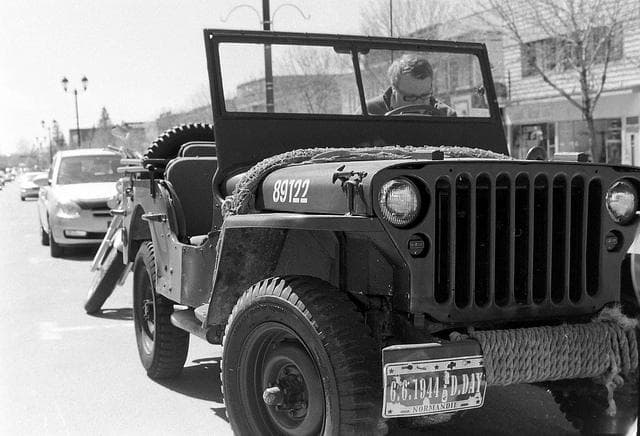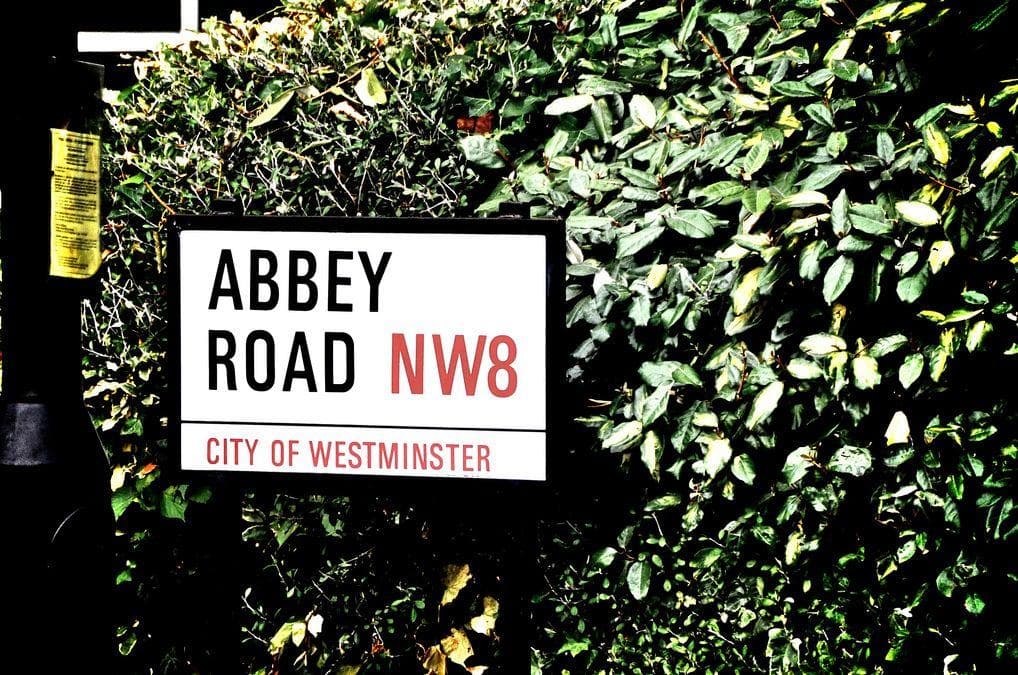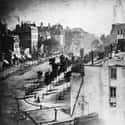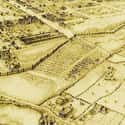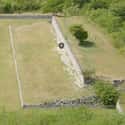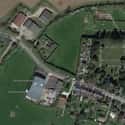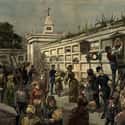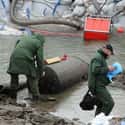-
(#1) A Mummified Toddler Was Found In A Parisian Apartment
In 1850, a Parisian couple was having work done in their apartment when the mummified remains of a baby fell out of a wall. At first, there was a lot of suspicion about the couple. But Dr. Marcel Bereget decided to determine the amount of time since death by using common house flies to see if they would swarm over the body. It was determined that the child had passed quite some time ago.
There was no further information about who the child was or how he or she perished and ended up in the wall. Likely, the child had been there for years.
-
(#2) A 700-Year-Old Mummy Was Found Under A Chinese Road
In 2011, a very well-preserved mummified woman was found underneath a modern road in the city of Taizhou, in the Jiangsu Province of eastern China. The woman, a member of the Ming Dynasty, was found by a construction crew working on a road that she was buried under. Construction workers described her as being submerged in a "‘brown liquid."
She was just under five feet tall, and dressed in silk finery with robes, slippers, jewelry. Amazingly, her hair and eyebrows were still intact. After observing her and her tomb, Taizhou Museum director Wang Weiyin estimated that the mummy was about 700 years old.
-
(#3) A Child's Letter To Santa Claus From 1943 Was Found In A Chimney
A letter was written by a little boy named David and addressed to Santa Claus during Christmas 1943. The letter was presumably placed with care inside the chimney of David’s home. Seventy-two years later, contractor Lewis Shaw was helping demolish the same home when his crew found the letter, still inside the chimney. It read:
“Dear Father Christmas,
Please can you send me a Rupert annual, and a drum box of chalks, soldiers and Indians, slippers and any little toys you have to spare,
Love
David”
Miraculously, this letter was reunited with David. Shaw tried to track him down with Facebook and by speaking to neighbors who still lived close by. The search even gave birth to a social media campaign, #FindDavid. Shaw eventually found the still-living David.
-
(#4) An 1894 Time Capsule Was Discovered Under A Scottish Bridge
In 2015, in the Cairngorms National Park in Scotland, a 121-year-old time capsule was discovered by construction workers on a section of the Ruthven Road bridge. The capsule itself was a metal box, similar to a safe-deposit box at a bank.
When the capsule was opened, the items inside that were found included: a bottle of whisky, a newspaper from 1894, a scroll, and some other items. The items and the box itself were donated to the nearby Highland Folk Museum to be studied. It is believed that the time capsule was placed within the structure of the bridge when it was originally constructed at the end of the 19th century.
-
(#5) A 13th Century Mansion Was Found Under Somerset, England
In 2013, during construction for a housing development in Wellington, England, excavators discovered the foundations of a 12th-century mansion. Archeologists working on the discovery later discovered that there were no historical records of the building. Normally, large estates have deeds and other records kept by the occupants, local lords, or with church officials.
While no sufficient information about the mansion’s history or occupants has ever been found, archeologists did discover a segment of tile in the mansion with a knight painted on it. Because this is similar to tiles at Glastonbury Abbey, this revelation made the site and mansion foundations instantly more important and of great historical value. While the housing project continued, the artifacts uncovered from the archeological dig ended up being moved to the Museum of Somerset for study and preservation.
-
(#6) A 17th Century African Burial Ground Was Found In Manhattan
History is often obscured by the fog of time and, more literally, rubble. In 1991, plans to build a new federal building in lower Manhattan began with excavation just north of the Tweed Courthouse in what is now Chinatown.
As excavation progressed, workers discovered a seventeenth century burial ground where African people, enslaved in what was then the Dutch colony of New Amsterdam, had been continually interred for about century, between the 1690s and the 1790s. The site sits between Broadway and Centre Street, near Thomas Paine Park.
Once discovered, the building construction was stopped and further archeological excavation of the site unearthed the remains. Some individuals were even identified, notably Groot Manuel, who was identified by his living descendant, Christopher Moore.
Two years later, the site was recognized as a national historic landmark. A decade later, the remains of over a dozen individuals were ceremoniously reburied, and in 2006 President George W. Bush proclaimed the area a national monument. The discovery and preservation of the burial ground is of huge importance to both African-American history and American history as a whole.
-
(#7) A Medieval Hospital Was Found In Madrid, Underneath The Future Site Of An Apple Store
The bubonic plague swept from Italy through Europe. Hospitals became overwhelmed with plague victims, and many had to be shut down and abandoned when no physicians were left to treat sick patients. In 2013, the foundations of one of those hospitals was unearthed in Madrid when Spanish construction crews began excavating for the new Apple Store that was to be built there.
The hospital dates from the 15th century, and was specifically used to treat sufferers of the bubonic plague. It continued to be used well into the 19th century, but it was closed and torn down in the 1850s.
-
(#8) A 60,000-Year-Old Wooly Mammoth Tusk Was Found In Washington State
Beneath the modern frame and foundation of a residential building in Seattle, lay a single, fossilized tusk of mammuthus columbi, the Columbian Mammoth. The fossilized tusk found beneath the building measured over eight feet long, according to paleontologists who were called in to examine the find.
After closer inspection, it was confidently assessed to be at least 60,000 years old and would need to be carbon dated. Particular credit should be given to AMLI, the residential company that owned the building and land, for taking the step to request that the tusk be removed and preserved by paleontologists. The tusk was soon taken to the Burke Museum of Natural History and Culture in Seattle.
-
(#9) Around Two Dozen Coffins Were Found Under A Philadelphia Apartment Building
In March 2017, construction crews working on an apartment complex in Philadelphia unearthed scores of fully intact human remains and coffins. It's speculated that the remains are from the 18th century, as the nearby Betsy Ross House was allegedly an old burial ground for the First Baptist Church.
When the church moved sometime around 1860, they were supposed to exhume and re-inter all of their parishioners remains. Clearly, they cut some corners. The remains discovered were sent to the forensics lab at Rutgers-Camden, with the hope of identifying them, cleaning them, and analyzing them. The ultimate resting place (after documentation) is Mount Moriah Cemetery.
-
(#10) A 1,500-Year-Old Byzantine Church Beneath Was Found Beneath A Highway
Honestly, it's kind of hard to dig anywhere in Israel and not find something of immense historic value. Along the side of an ancient road the remains of a 1,500-year-old Byzantine church were discovered when construction workers were performing routine maintenance on a modern highway very close to where the church was located.
Situated close to Jerusalem, the church had a white marble floor and cruciform-shaped baptisterium (a small pool where worshipers and adherents are baptized into the faith). In addition to the church itself, lots of smaller items were discovered and saved from destruction of the road maintenance. Among the items found were; mother of pearl shells, glass jars, marble, and oil lamps. Netivei Israel, the National Transportation Infrastructure Company, has taken steps to preserve the entire site for people to see.
-
(#11) An Ancient Mayan Ball Court Was Uncovered In Mexico
In 2006, a housing project uncovered ancient historical ruins in Yucatan, Mexico. Thankfully, the National Institute of Anthropology was asked to step in when the remains of a Mayan ballgame court was discovered under the construction site.
Fernando Acevedo and Donato Espana discovered that the court was 2,500-years-old and quite large, with a maximum length of 82 feet and a width of 15 feet. The court was used for a ballgame that also played an important cultural role in the Mayan religion. This important heritage site was ultimately saved from destruction.
-
(#12) More Than 40 Skeletons Possibly From The 11th Or 17th Century Were Found In England
Construction workers in Buckingham, southern England, discovered 42 buried skeletons while preparing a new development on former farmland. The skeletons' hands were pressumably tied behind their backs, and archaeologists speculate they were either from Anglo-Saxon Britain or the English Civil War from 1642 to 1651. They could even be prisoners who perished on gallows, but the official report is highly classified. Neighboring townspeople are demanding information given the "historical significance" of the area.
According to the MK Citizen, Places for People, the company that owns the land and is planning the development, had to commision an archaeological investigation, which is how the remains were discovered.
-
(#13) The 2,200-Year-Old, Long-Lost Temple Of Pharaoh Ptolemy IV Was Found In Egypt
The Egyptian Ministry of Antiquities announced that construction workers drilling a new sewage drain in Kom Shakau village in Tama township in northern Sohag in Egypt uncovered the 2,200-year-old long-lost temple of Pharaoh Ptolemy IV. He was the fourth pharaoh of Ptolemaic Egypt from 221 BC to 205 BC when he perished.
On October 2, 2019, the secretary-general of the Supreme Council of Antiquities, Mostafa Waziri, said construction was suspended while archeologists attempt to uncover the temple ruins. The drilling team found several limestone walls with inscriptions, one of which is Ptolemy IV's name.
-
(#14) An 18th Century Cemetery Was Found At A Site For A New Orleans Swimming Pool
In 2011, Vincent Marcello was prepared to find remains when he wanted to build a new pool, and so decided to hire archeologist Ryan Gray to dig in the area before construction began.
As all involved suspected, Gray did find human remains. In fact, he uncovered 15 wooden coffins where the new pool was to be installed. It turns out that these dearly departed were interred in the larger Saint Peter Cemetery of New Orleans. This was not surprising to anyone (insanely) because bones and whole skeletons were unearthed in the '80s during another building project nearby. With the utmost care and respect, Gray’s team sent all coffins and human remains, as found, to Louisiana State University to be studied and cared for.
-
(#15) Whale Bones Were Found Under A Light Rail Dig Site In Edinburgh
Experts at the National Museum of Scotland identified two large male sperm whale fin bones discovered by workers at a light rail system construction sight on the port of Leith in Edinburgh, Scotland. According to the Scotsman, the bones might have been a trophy from one of many whaling expeditions from 1616 to 1963. Researchers preface that the bones could be nearly 800 years old.
City of Edinburgh archaeologist John Lawson said, "These bones provide a rare glimpse into and also a physical link with Leith's whaling past, one of its lesser-known maritime industries and one which in the 20th century reached as far as the Antarctic."
Other interesting discoveries from the Trams construction site on Constitution Street include a wall from 1790 surrounding a graveyard, a historic graveyard, a cannonball, and the South Leith Parish Church wall.
-
(#16) An Unexploded WW2 Era RAF Bomb Was Uncovered In Berlin
During the Second World War, Allied bombing campaigns dropped a total of 3.4 million tons of explosives. A lot of those bombs, possibly as many as 15 percent, didn’t detonate. They simply disappeared during reconstruction efforts after the war was over. As a result, many countries in Europe and Asia continue to find unexploded ordnance underneath buildings and other public places.
On Christmas Day 2016 in the Schwabian city of Augsburg in Bavaria, a four-thousand pound (two ton) RAF bomb from World War Two was discovered underneath a construction site. This forced the evacuation of 54,000 local inhabitants.
New Random Displays Display All By Ranking
About This Tool
Our data comes from Ranker, If you want to participate in the ranking of items displayed on this page, please click here.




